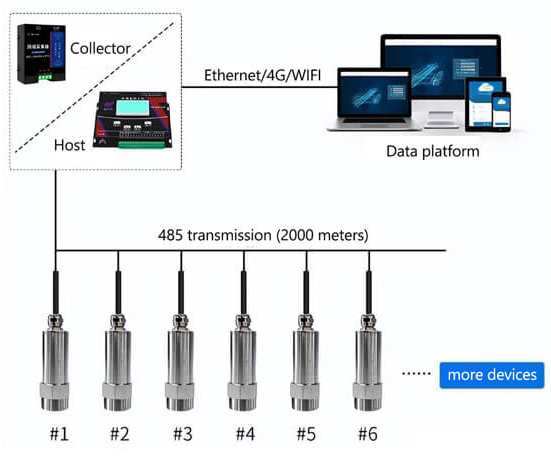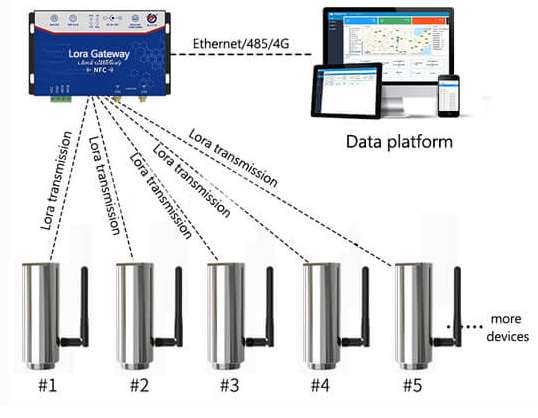
Renke Industrial Vibration Sensor
Product Description
The vibration and temperature sensor has many output signals, the more commonly used ones are analog output, rs485 output, and LoRa output.
The temperature vibration sensor uses 485 signal or LoRa signal to measure the speed of X, Y, and Z axes. Measure the vibration velocity, vibration displacement and temperature. If the vibration acceleration is to be measured in the use environment, it is also possible. For our temperature vibration sensor, the vibration speed range is generally 0-50mm/s. If the measuring equipment does not match this range, you can choose any other range.
Product Features
- The protection grade is IP67. The shell is 304 stainless steel, small and durable. This iot vibration sensor can be used in many environments.
- Can measure X, Y, Z three-axis speed. The vibration speed range is 0-5000μm, whether it is 0-100μm, 0-200μm, 0-1000μm equipment, or 0-2000μm equipment, all ok.
- Installing industrial vibration sensor at different measuring points, the vibration signals and temperature changes of the equipment can be measured. Then upload it to the data platform, and users can grasp the equipment status anytime and anywhere,
- Users can filter by time in the historical data in the platform at any time, and quickly query the required data. It is also possible to convert the data into monthly reports and weekly reports, and export and print them in forms/polylines.
- When the device information is abnormal, the system will send the alarm information to the contact person by phone, text message, page turning red, email, etc.
- The user can check the alarm information and frequency through the historical record, so as to judge the mechanical operating life. Determine whether major repairs or replacements are required.
Three Types of Vibration Sensors
1. Modbus vibration sensor
The RS485 vibration sensor uses a 10-30V DC wide voltage power supply. Suitable for dry, humid, noisy, and other environments, waterproof and dustproof. The measurement data is transmitted through the signal line, free from environmental interference, safe and stable. The Modbus vibration sensor can measure a single axis or three axes.
Parameters
- Power supply: DC10-30V
- Frequency range: 10-1600Hz
- Working environment: -40~+80, 0%RH~80%RH
- Vibration speed range: 0-50mm/s
- Vibration velocity accuracy: ±1.5% FS (@1kHz, 10mm/s)
- Vibration velocity resolution: 0.1mm/s
- Vibration displacement range: 0-5000μm
- Vibration displacement resolution: 0.1μm
- Surface temperature range: -40~+80
- Temperature display resolution: 0.1°C

The transmission distance is long, up to 2000 meters, which can realize remote monitoring. If there are few measuring points, you can choose a network collector, which can not only reduce the cost, but also meet your own needs.
2. Lora vibration sensor
The wireless vibration sensor is easy to use, and the wireless digital signal transmission method eliminates the noise interference caused by long cable transmission. The entire measurement system has extremely high measurement accuracy and anti-interference ability. Wireless vibration sensor nodes can form a huge wireless sensor network to monitor multiple locations simultaneously. The node structure is compact and the data transmission is fast. The wireless vibration sensor is compact and easy to install.
The wireless vibration sensor transmits the LoRa signal to measure the motor surface temperature, vibration speed and other data in real-time. Users can view it on their mobile phones or computers anytime, anywhere, fully grasp the operation of the motor, and establish a complete monitoring system for rotating equipment. It is a triaxial vibration sensor that can measure the vibration speed of X/Y/Z three axes.
Parameters
- Power supply: 3.6V lithium battery
- Frequency range (Hz): 10-1600/10-5000 (optional)
- Working environment: -40~+80, 0%RH~80%RH
- Vibration speed range: 0-50mm/s
- Vibration velocity accuracy: ±1.5% FS (@1kHz, 10mm/s)
- Vibration velocity resolution: 0.1mm/s
- Surface temperature range: -40~+80
- Temperature resolution: 0.1°C
- Configuration method: Bluetooth configuration

3. Analog vibration sensor
Analog vibration sensor, which can convert vibration signal into analog output. The measuring point data is collected and uploaded to the host computer through the PLC. The staff can monitor the vibration velocity, displacement and temperature changes of each measuring point in real time. Analog vibration sensors can only measure a single axis. The output modes are 0-5V, 0-10V, 4-20mA.
Parameters
- Power supply: DC10-30V
- Frequency range (Hz): 10-1600 or 10-5000 (optional)
- Vibration measurement direction: uniaxial, perpendicular to the direction of the measurement surface
- Working environment: -40~+60, 0%RH~80%RH
- Vibration speed range: 0-50mm/s
- Surface temperature range: -40~+80
- Vibration velocity accuracy: ±1.5% FS (@1kHz, 10mm/s)
- หน้าหลัก หน้าหลัก
- สินค้าอุตสาหกรรม สินค้าอุตสาหกรรม
- สินค้าเซนเซอร์ สินค้าเซนเซอร์
- บริการของเรา บริการของเรา
- บทความและข่าวสาร บทความและข่าวสาร
- ติดต่อเรา ติดต่อเรา



